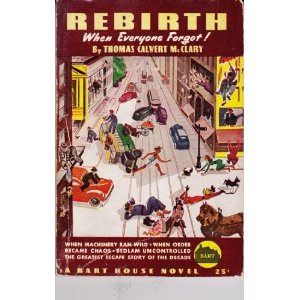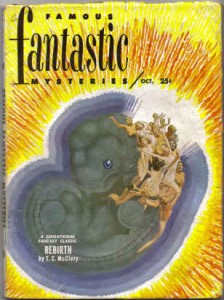Is This The Worst Science Fiction Novel Ever?
This is another installment in my continuing review of 1950’s sf novels. It barely squeaks by the criterion of “1950s sf novel” because of its reprinting by FFM in 1951. And to answer my question right off the bat, sadly, probably no. But it is the worst sf novel I’ve read in the last thirty years or so, and only my extreme dedication to my review project made me carry through and finish it.
McClary, Thomas Calvert (1909-1972): Rebirth: When Everyone Forgot! Revised and probable expansion of two-part ASF serial 2 & 3, 1934. First (and only) book publication, 1944. Appeared in Famous Fantastic Mysteries in 1951.
Characters: There are no characters in this book. There are names and professions. Any differences in the name’s personality is based on their profession (ie, cops, tough and violent; professors, weak, sometimes smart, sometimes lazy). When everyone forgets everything and become “cave” men and women, it becomes difficult to remember who’s who because they’re all just names. 8
Setting 1958 NYC. McClary does a little science-fictional hand-waving (consisting of a couple of paragraphs) where he describes two-wheeled cars going seventy miles per hour and how the wealthy live on the top level of the city and the poor live in tunnels underneath the ground “lower than worms.” Even those token sf elements are entirely forgotten when everyone “forgets.” There’s hardly any indication as to where in the city the action takes place, and no discernible landmarks are ever mentioned. 9
Plot. It starts out reasonably at a dinner party where everyone has real names and indulge in actual conversation. Not that much of the conversation makes any sense. It seems that Rayne Goddard, “indisputably the most brilliant scientist of modern times,” is royally pissed about how society works. You know, there are rich people and poor people. People are stupid and stubbornly cling to outmoded ideas and economic policies. Fortunately, “now that I have found the cosmic shock wave,” he can do something about it. He disappears (only to reappear in the last chapter) and unleashes the “cosmic shock wave” on the world without a clue as to how this thing actually works. Everyone is knocked out and when they wake up they can’t remember anything. Three days after his super weapon is unleashed, half of the population of NYC is dead. One quarter is insane. Hundreds of thousands are maimed. And everyone who survives is a complete moron who figure out things like realizing that they’re thirsty and need to drink water. (Fortunately, the main character has a couple of dogs, and learns about water from them, though it takes him awhile to get right, choking away as he figures out how to drink. They also can’t talk, so for the rest of the book (pgs. 22-187) there is no dialog and the story is told in straight reportage. For some reason, though everyone has forgotten everything, they think of the buildings as “caves” (as if that would be the first thing to come to the minds of NYC residents). There are numerous other stupidities: Though they eventually develop a complicated sign language, they talk only in grunts and other noises. After ten years go by they have a spoken language consisting of 1000 words. After a couple of months of this “caveman” existence, a hunting party makes asses of themselves by attacking a merry-go-round, thinking the wooden horses are actually animals. In fact, they call everything (ie, a piano, various mechanical devices) animals, unable to distinguish between animate and inanimate objects. They go into a museum and attack portraits hanging on the walls, because they think the portraits may attack them. The caveman metaphor is taken to the extreme. (One main character is actually called “Ug.”) They propagate few laws, but the penalty for breaking all of them is death. (People are put to death for being lazy, sick or injured, mentally ill, or not taking enough baths.) The book is horribly sexist. Men regularly beat their woman, who take it in all good humor. Almost all are beaten regularly in public, to the vast approval of the tribe. Early on a woman is traded first for a dog, then a badge from a policeman’s coat. The cavemen are described as “too ignorant to feel great fear,” even when the band of “good guys” learn how to use guns and blast the crap out of an attacking horde of 40,000 roving “barbarians” who roam homeless around Manhattan. (Really. Forty thousand. What do they eat, grass and dirt?). That battle is the culmination of the repetitive plot: wherein the “good guys” come upon another band of people; fight them; kill most; make slaves of the rest. Then they came upon a slightly larger band, fight them; kill them; make slaves of the rest. Finally, after about ten, twelve years, when the hero has the entire North American continent under his control (but nobody has figured out how to “make” electricity yet), Goddard shows up again in Manhattan, where his patient and love-suffering girlfriend gives herself to him, because, even though she forgot everything somehow she recognizes him. I would have stood him up against the wall and shot him. By all measures, this is the worst plot I have ever encountered in a sf novel. 1
Style: Here’s an example of the prose from the beginning chapter, where McClary is at his very best: “…everywhere the city beat with its kaleidoscopic shifting sameness.” After that it’s simple journalism: and then they did this, and then they did that, and then, in the spring, babies were born. The men were astounded. 10
Contemporary reviews by Anthony Boucher: “…inept, improbable, and crudely written.” Boucher was entirely too kind. Usually, when I read a bad book or watch a bad movie I say that I took abullet so you won’t have to. In this case, I took the entire clip.
Rating: 7 (and remember, that’s on a scale of 1-100)


There are no comments